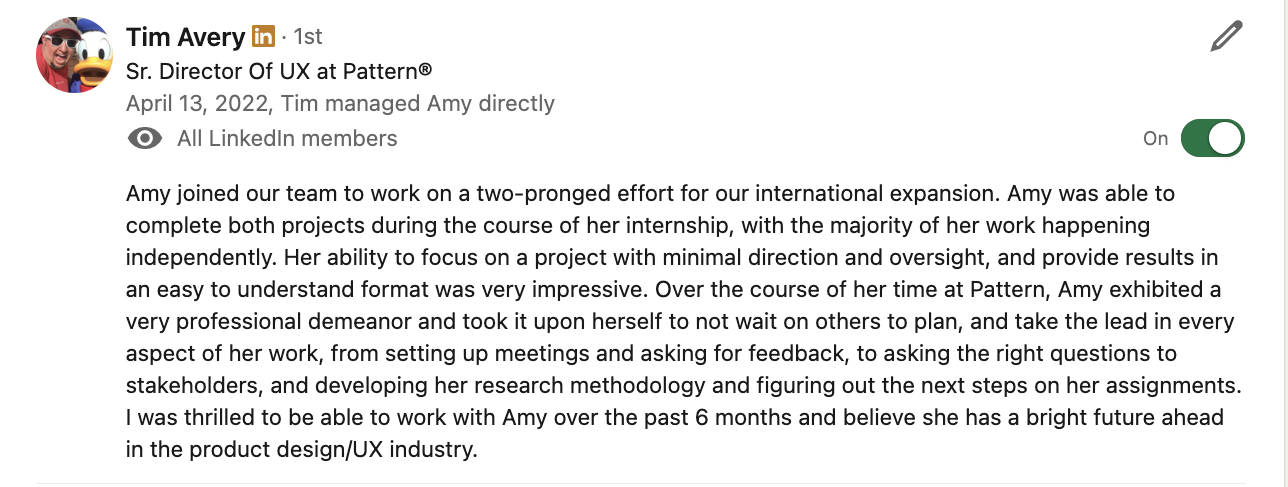Pattern Experience Localization
Crafting Locally Relevant Experiences for International Users
Pattern
Timeline: November 2021 – April 2022
Role: UX Intern
Core Responsibilities: User Research, Product Design, Design Localization
Key results: User Research Discovery Deck, Localized UI/UX, Product Localization Roadmap
Team: 1 Design Director, 1PM Director, 1 PM Intern (sibling team)
Tool: Adobe XD
During the winter of 2021 and spring of 2022, I interned as a UX intern at Pattern. As a bilingual speaker, I was really excited to work on a localization project. While my office was in the US, I was acting as a liaison between our US headquarters and offices in Asia. My work primarily served the needs of Predict (one of Pattern’s products) users in Asia to support Pattern’s international expansion to Chinese marketplaces, so I conducted user research with 10+ local users across China, Hong Kong, and Singapore. I also collaborated closely with Product Managers across multiple Pattern products to craft a cohesive and customer-centric experience.
This project is under a Non-Disclosure Agreement (NDA), so unfortunately I cannot share the project specifics. In this case study, I’ll highlight the transferable competencies that I improved on without divulging confidential details.
Context
Designer with multiple hats
This project was a user research and communication-intensive design initiative where I wore multiple hats: user researcher studying end-customer behaviors in China, liaison for the U.S. design team to internal users in Asia, and designer on the US-based Product Design team at our headquarter.
Our goal was to adapt a US- and EU- based B2B2C product (Predict) for users in China, Hong Kong, and Singapore—markets with unique user behaviors, motivations, and preferences. Success required a nuanced understanding of local user needs while maintaining alignment with the company’s global design visions.
To navigate the complexity of this project, I focused on gathering rich, actionable insights from multiple user groups and facilitating communication across teams!
Cross-cultural user research and comparative insights
I started by conducting focus group interviews with US-based internal users, grouped by specialized roles, to understand the product's current strengths and pain points. Then, I conducted 7 individual interviews with local users across China, Hong Kong, and Singapore to uncover region-specific needs and cultural nuances.
Strategic design artifacts
To bridge the gap between insights and action, I created personas and user needs statements. These artifacts were designed to inform and align the US Product Design team with the realities and needs of our international users, serving as both communication tools and documentation for future reference.
Design localization
Based on research findings, I adapted our user interfaces while incorporating the design system to meet the unique needs of Chinese users. I also created localized screen flows to begin the discussions around product adoption. Beyond design, I translated UI strings and crafted core user flows for the MVP release in the Chinese market.
Roadmap planning
Recognizing the high-impact nature of this project, I was tasked with drafting a quarter-by-quarter roadmap for the entire localization effort. With guidance from my manager (a design director and strategic leader), I learned to map out the stages of product localization in a way that balanced viability and efficiency.
Outcome
Groundwork laid for internationalization
The project laid the groundwork for a product that resonated deeply with Chinese users, with adaptations informed by thorough user research and cross-team collaboration. The personas and user needs statements ensured that the US team understood the local market, and the roadmap provided clear direction for future development.
Reflection
Impact really isn’t defined by job title
Being entrusted with such important responsibilities was both challenging and rewarding. This experience strengthened my ability to manage cross-cultural communication, execute user research, craft intentional design, and contribute to strategic planning. I’m especially grateful to my manager, Tim, for empowering me to take ownership of this project and guiding me through the complexities of localization.







